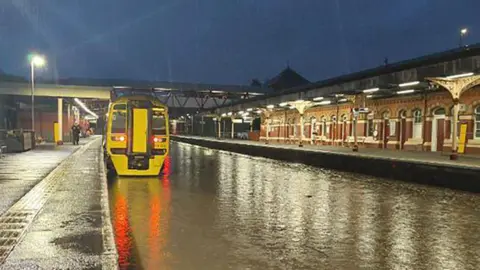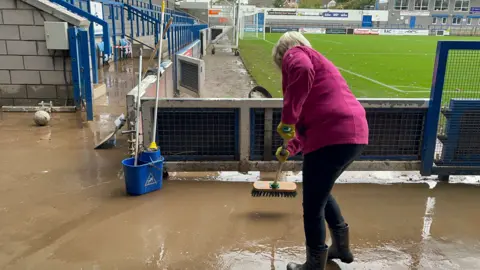 West Midlands Police
West Midlands PoliceHeavy rain has caused travel disruption in England, with roads closed and rail services cancelled because of floodwaters.
Water reached up to the windows of abandoned cars in Birmingham, while submerged rail lines caused cancellations out of London and in Shropshire.
The M5 was earlier re-opened after being shut because of “significant” flooding that left motorists stranded. Officials say the A421 in Bedfordshire could take weeks to reopen after days of torrential rain.
More rain is forecast for Sunday, posing the risk of further flooding into next week.
Some areas have seen up to four times their average monthly rainfall this week, leaving the ground and waterways saturated.
 PA Media
PA Media Reuters
ReutersThere were 58 flood warnings in place across England as of 21:00 BST, meaning flooding was expected in those areas.
People were rescued after being stranded on the M5 overnight. The motorway has now reopened between junctions 14 and 16 near Bristol.
In Birmingham, a man had to be rescued by police when his car became submerged in floodwaters on Thursday evening. Another became stranded in nearby Stourbridge.
All services between Shrewsbury in Shropshire and Wolverhampton were cancelled after rail lines became completely submerged at Wellington station.
Rail firm LNER said flooding might cause ongoing delays to services to and from London King’s Cross and Peterborough.
Meanwhile, flooding between Purley, south London, and Caterham in Surrey temporarily blocked Southern Rail lines on Friday morning.
In Oxfordshire, flooding left roads submerged and blocked rail lines running between Bicester North and Banbury.
Residents have also been evacuated after the River Ock burst its banks.
It is not the first river to do so this week. Rising river levels have seen homes flood near the River Great Ouse in Bedfordshire.
Several homes in Hitchin, Hertfordshire, also flooded after the River Purwell burst its banks.
One resident said he felt “so helpless and vulnerable” seeing water coming into the properties, with some of his neighbours now unable to get insurance on their homes.
Areas in the north of England have seen the most rain, with Flyingdales, North Yorkshire, seeing one month’s worth of rain (81mm, 3.2in) in two days.
The rainfall over the past few days adds to what has been an unusually wet September for parts of southern England.
In Woburn, Bedfordshire, there has been four times as much rainfall than is usual for the time of year, making this September the wettest month ever recorded in the town.
Dozens of volunteers helped clean up AFC Telford’s stadium, where flash flooding had left the pitch under water.
A care home in Shropshire was also flooded, with residents having to be temporarily relocated to another home.
 BBC/Ellen Knight
BBC/Ellen KnightSaturday is expected to be drier, but more rain is forecast to arrive on Sunday.
While it is not anticipated to be a lot, the ground is still expected to be saturated from earlier rainfall, posing a further risk of flooding.
The Environment Agency also warned that the pause in rainfall might not stop river levels rising.
Nick Green, the agency’s incident manager for the West Midlands, said it was “going to take a few days” for water in smaller brooks to “work its way down” into rivers.
After a week of yellow weather warnings for rain, the Met Office has issued one for wind for Sunday.
Coastal areas may see large waves and water overtopping with some disruption to transport networks.
Floods minister Emma Hardy met Environment Agency chief executive Philip Duffy on Friday to discuss the response to this week’s flooding and praised emergency responders and volunteers.
She said: “We are redoubling efforts to repair and maintain our flood defences and work with communities across the country to prepare for more wet weather this autumn.”


